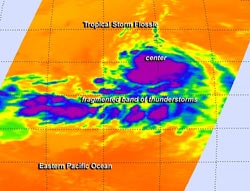NASA's Infrared Data Shows Tropical Storm Flossie's Strength

The AIRS instrument aboard NASA's Aqua satellite captured this infrared image of Tropical Storm Flossie on July 25. Strongest storms and heaviest rains are around the center and in a fragmented band of thunderstorms south of the center with cloud top temperatures near -63F/-52C (purple). <br>Image Credit: NASA JPL/Ed Olsen<br>
The Atmospheric Infrared Sounder or AIRS instrument flies aboard NASA's Aqua satellite. AIRS captured an infrared image of Tropical Storm Flossie on July 25 at 10:05 UTC (6:05 a.m. EDT). Infrared data helps determine temperature, such as the cloud top and sea surface temperatures.
AIRS data revealed that Flossie's strongest storms and heaviest rains were around its center and in a fragmented band of thunderstorms south of the center. Those areas had cloud top temperatures near -63F/-52C, indicating very high thunderstorms.
The National Hurricane Center or NHC noted that at 8 a.m. PDT (11 a.m. EDT) the center of Tropical Storm Flossie was near latitude 15.3 north and longitude 125.6 west. Flossie is moving toward the west near 16 mph (26 kph) and is expected to continue in that direction for the next couple of days. Flossie's maximum sustained winds remain near 40 mph (65 kph) and NHC expects some strengthening during the next 48 hours. The estimated minimum central pressure is 1003 millibars.
The NHC's current forecast track takes Flossie toward Hawaii as a depression by Tuesday, July 30.
Text credit: Rob Gutro
NASA's Goddard Space Flight Center
Media Contact
All latest news from the category: Earth Sciences
Earth Sciences (also referred to as Geosciences), which deals with basic issues surrounding our planet, plays a vital role in the area of energy and raw materials supply.
Earth Sciences comprises subjects such as geology, geography, geological informatics, paleontology, mineralogy, petrography, crystallography, geophysics, geodesy, glaciology, cartography, photogrammetry, meteorology and seismology, early-warning systems, earthquake research and polar research.
Newest articles

Superradiant atoms could push the boundaries of how precisely time can be measured
Superradiant atoms can help us measure time more precisely than ever. In a new study, researchers from the University of Copenhagen present a new method for measuring the time interval,…

Ion thermoelectric conversion devices for near room temperature
The electrode sheet of the thermoelectric device consists of ionic hydrogel, which is sandwiched between the electrodes to form, and the Prussian blue on the electrode undergoes a redox reaction…

Zap Energy achieves 37-million-degree temperatures in a compact device
New publication reports record electron temperatures for a small-scale, sheared-flow-stabilized Z-pinch fusion device. In the nine decades since humans first produced fusion reactions, only a few fusion technologies have demonstrated…





















